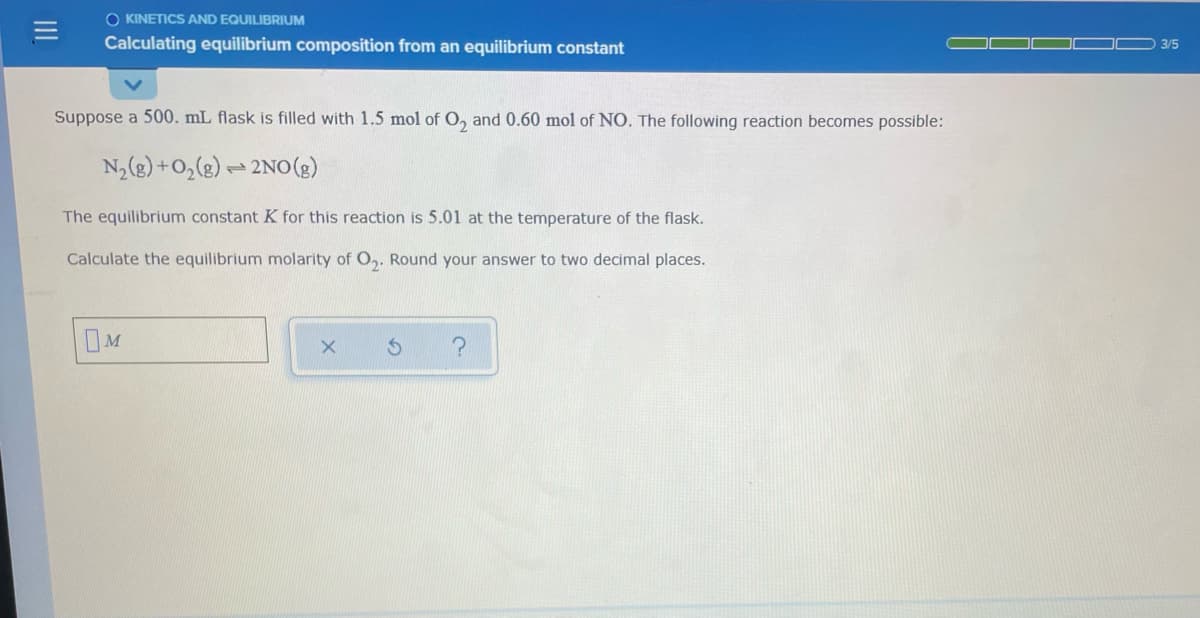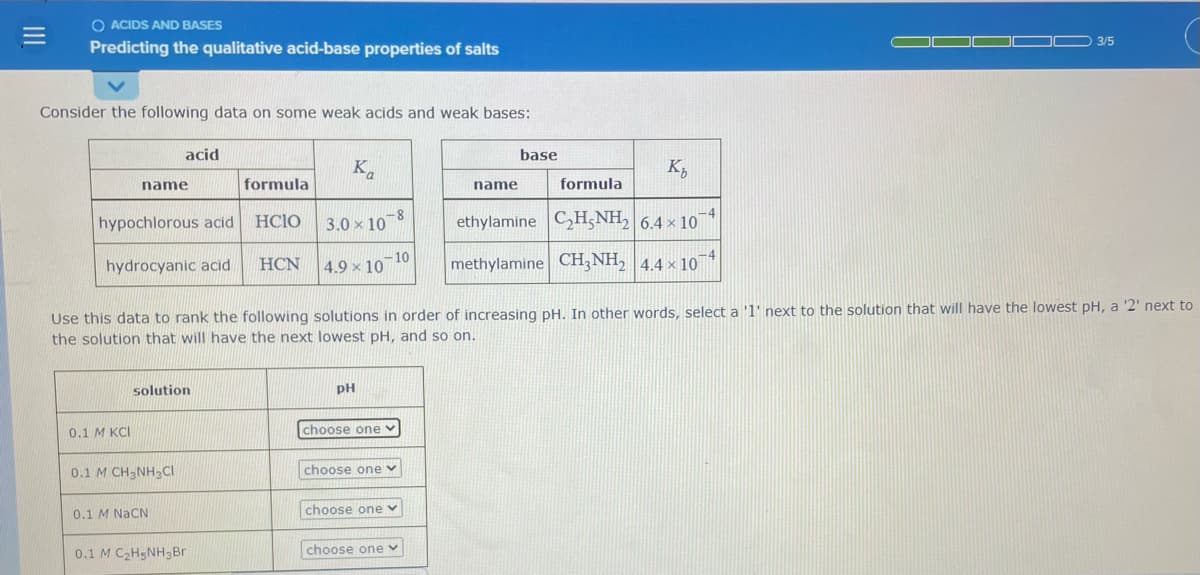Suppose a 500. mL flask is filled with 1.5 mol of O, and 0.60 mol of NO. The following reaction becomes possible: N,(g) +O,(g) – 2NO(g) The equilibrium constant K for this reaction is 5.01 at the temperature of the flask. Calculate the equilibrium molarity of O,. Round your answer to two decimal places.
Suppose a 500. mL flask is filled with 1.5 mol of O, and 0.60 mol of NO. The following reaction becomes possible: N,(g) +O,(g) – 2NO(g) The equilibrium constant K for this reaction is 5.01 at the temperature of the flask. Calculate the equilibrium molarity of O,. Round your answer to two decimal places.
Chemistry: The Molecular Science
5th Edition
ISBN:9781285199047
Author:John W. Moore, Conrad L. Stanitski
Publisher:John W. Moore, Conrad L. Stanitski
Chapter12: Chemical Equilibrium
Section: Chapter Questions
Problem 62QRT
Related questions
Question

Transcribed Image Text:O KINETICS AND EQUILIBRIUM
Calculating equilibrium composition from an equilibrium constant
O3/5
Suppose a 500. mL flask is filled with 1.5 mol of O, and 0.60 mol of NO. The following reaction becomes possible:
N2(g) +O,(g) – 2NO(g)
The equilibrium constant K for this reaction is 5.01 at the temperature of the flask.
Calculate the equilibrium molarity of O,. Round your answer to two decimal places.
M
II

Transcribed Image Text:O ACIDS AND BASES
O 3/5
Predicting the qualitative acid-base properties of salts
Consider the following data on some weak acids and weak bases:
acid
base
K.
K,
name
formula
name
formula
-8
hypochlorous acid
HCIO
3.0 x 10
ethylamine C2H5NH, 6.4 × 10
hydrocyanic acid
HCN
4.9 x 10 10
methylamine CH;NH, 4.4 × 10™
Use this data to rank the following solutions in order of increasing pH. In other words, select a '1' next to the solution that will have the lowest pH, a '2' next to
the solution that will have the next lowest pH, and so on.
solution
pH
0.1 M KCI
choose one v
0.1 M CH3NH3CI
choose one v
0.1 M NaCN
choose one v
0.1 M C2H5NH3B.
choose one v
II
Expert Solution
This question has been solved!
Explore an expertly crafted, step-by-step solution for a thorough understanding of key concepts.
Step by step
Solved in 7 steps with 3 images

Knowledge Booster
Learn more about
Need a deep-dive on the concept behind this application? Look no further. Learn more about this topic, chemistry and related others by exploring similar questions and additional content below.Recommended textbooks for you

Chemistry: The Molecular Science
Chemistry
ISBN:
9781285199047
Author:
John W. Moore, Conrad L. Stanitski
Publisher:
Cengage Learning

Introduction to General, Organic and Biochemistry
Chemistry
ISBN:
9781285869759
Author:
Frederick A. Bettelheim, William H. Brown, Mary K. Campbell, Shawn O. Farrell, Omar Torres
Publisher:
Cengage Learning

Chemistry for Engineering Students
Chemistry
ISBN:
9781337398909
Author:
Lawrence S. Brown, Tom Holme
Publisher:
Cengage Learning

Chemistry: The Molecular Science
Chemistry
ISBN:
9781285199047
Author:
John W. Moore, Conrad L. Stanitski
Publisher:
Cengage Learning

Introduction to General, Organic and Biochemistry
Chemistry
ISBN:
9781285869759
Author:
Frederick A. Bettelheim, William H. Brown, Mary K. Campbell, Shawn O. Farrell, Omar Torres
Publisher:
Cengage Learning

Chemistry for Engineering Students
Chemistry
ISBN:
9781337398909
Author:
Lawrence S. Brown, Tom Holme
Publisher:
Cengage Learning


Chemistry
Chemistry
ISBN:
9781305957404
Author:
Steven S. Zumdahl, Susan A. Zumdahl, Donald J. DeCoste
Publisher:
Cengage Learning

Chemistry: An Atoms First Approach
Chemistry
ISBN:
9781305079243
Author:
Steven S. Zumdahl, Susan A. Zumdahl
Publisher:
Cengage Learning